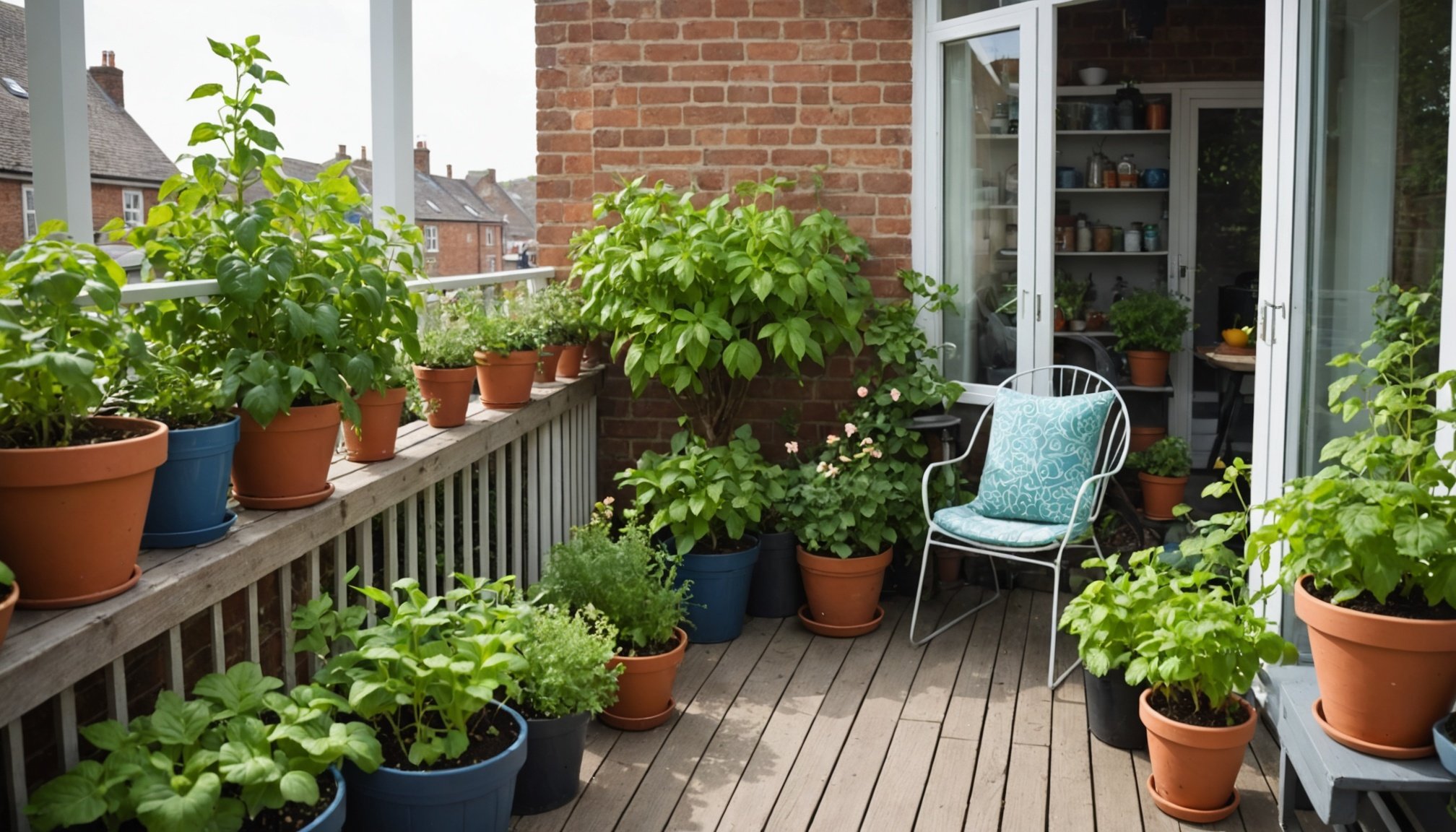Creating a vibrant spice garden on a balcony is entirely possible, even in the UK’s limited sunlight. With the right selection of plants and clever gardening techniques, you can grow aromatic herbs that thrive in partial shade. Discover practical tips to maximize your space, enhance light exposure, and select the best sun-friendly spices. Transform your balcony into a lush retreat, where culinary delights bloom, regardless of how much sun you receive. Let’s explore effective strategies to cultivate your very own spice haven!
Understanding the Challenges of Balcony Gardening in Limited Light
Balcony gardening in the UK often presents unique challenges, particularly when it comes to limited sunlight. Many urban gardeners find that their balconies receive only a few hours of direct sunlight each day, which can hinder plant growth. This is largely due to the orientation of buildings and the presence of surrounding structures that cast shadows.
Avez-vous vu cela : Creating an Inclusive Guest Bedroom: Designing for Diverse Accessibility Needs in Your UK Home
Gardeners face several common challenges under these conditions. First, selecting the right plants is crucial. Some plants thrive in low-light environments, but others may struggle without adequate sunlight. Additionally, limited light can affect the photosynthesis process, leading to slower growth and reduced flowering or fruiting.
Understanding and utilizing microclimates can be a game-changer for balcony gardening. Microclimates refer to the small-scale climate variations that occur in specific areas due to factors like wind patterns, shade, and heat retention. By identifying these microclimates, gardeners can strategically place their plants to maximize light exposure and create more favourable growing conditions.
A voir aussi : Top Flooring Choices for UK Homes with Underfloor Heating: A Comprehensive Guide
In summary, while balcony gardening in limited sunlight poses challenges, understanding these obstacles and leveraging microclimates can help urban gardeners cultivate a thriving green space.
Selecting Sun-Friendly Spices for Your Garden
When cultivating a spice garden on a balcony with limited sunlight, choosing the right sun-friendly spices is essential. These spices are characterized by their ability to adapt to low-light conditions while still thriving and producing robust flavours.
Characteristics of Spices That Thrive in Low Light
Spices that do well in low-light environments typically have certain traits. They often have broad leaves to capture as much light as possible and a slower growth rate, which allows them to conserve energy. Additionally, these plants are usually more tolerant of temperature fluctuations, making them ideal for UK climates.
Recommended Spice Varieties Suitable for UK Climates
For a successful spice garden selection, consider varieties like mint, parsley, and chives. These spices are not only hardy but also require less direct sunlight, making them perfect for shaded balconies. They can be grown in pots, allowing for easy movement to optimize light exposure.
Benefits of Growing Herbs Alongside Spices
Incorporating herbs into your spice garden offers numerous benefits. They can enhance the flavour profile of your culinary creations and aid in pest control. Herbs like basil and coriander complement spices well, creating a diverse and aromatic garden that thrives even in challenging conditions.
Maximizing Light Exposure on Your Balcony
To make the most of limited sunlight on your balcony, consider strategies for maximizing light. One effective approach is evaluating your balcony orientation. South-facing balconies typically receive the most sunlight, while north-facing ones may need creative solutions to enhance light exposure.
Tips for Optimizing Balcony Layout for Sunlight
Start by arranging your plants based on their light needs. Place those requiring more sunlight at the front, ensuring they aren't shaded by taller plants. Adjusting plant heights can help create a tiered effect, allowing each plant to capture available light efficiently.
Use of Reflective Surfaces to Enhance Light
Incorporating reflective surfaces can significantly boost light on your balcony. Mirrors or reflective panels can redirect sunlight onto shaded areas, increasing overall light exposure for your plants. This simple addition can create a brighter environment without altering the balcony structure.
Plant Positioning Strategies for Best Light Access
Experiment with plant positioning to find optimal light access. Rotate pots regularly to ensure even light distribution and prevent uneven growth. Additionally, consider mobile planters or hanging pots, which can be easily adjusted to follow the sun's path throughout the day. By implementing these strategies, you can create a thriving garden, even in less-than-ideal lighting conditions.
Soil and Container Considerations for Spice Growth
When engaging in container gardening for spices, the choice of soil plays a pivotal role in ensuring healthy spice growth. Selecting the right soil selection can significantly impact the vitality of your plants, especially in environments with limited light.
Importance of Soil Quality for Spice Health
High-quality soil is essential for spices to thrive. It should be well-draining to prevent waterlogging, which can lead to root rot. Incorporating organic matter, such as compost, can improve soil fertility and structure, providing the necessary nutrients for robust spice growth.
Recommended Potting Mixtures for Container Gardening
For optimal results, consider using a potting mixture that combines peat moss, perlite, and vermiculite. This blend ensures excellent drainage and aeration, crucial for the root systems of spices. Additionally, adding slow-release fertiliser can supply consistent nutrients over time, supporting continuous growth.
Types of Containers That Support Spice Growth in Limited Light
Choosing the right containers is equally important. Opt for containers with adequate drainage holes to prevent excess moisture retention. Materials like terracotta are ideal as they allow for better air circulation. Moreover, select containers that are light in colour to reflect sunlight, helping to maintain a stable temperature for your spices.
Watering Techniques for Success in Limited Sunlight
When cultivating a spice garden on a shaded balcony, effective watering techniques are crucial. Ensuring proper spice garden hydration is essential for healthy growth, especially in limited sunlight where evaporation rates are lower.
Best Practices for Watering Herbs and Spices
Watering should be done early in the morning or late in the afternoon to reduce evaporation. This timing allows the soil to absorb water efficiently, providing necessary hydration without waterlogging. Use a watering can with a narrow spout to direct water to the base of the plant, minimizing leaf wetness, which can lead to fungal diseases.
Importance of Moisture Retention in Shaded Areas
In shaded areas, maintaining consistent moisture levels is vital. Incorporating mulch can help retain soil moisture by reducing evaporation. Organic mulches like straw or bark chips are ideal as they also add nutrients to the soil as they decompose.
Signs of Overwatering and Underwatering
Recognising signs of overwatering and underwatering can prevent plant stress. Overwatering often results in yellowing leaves and wilting, while underwatering leads to dry, brittle leaves. Regularly check soil moisture by inserting a finger into the soil; it should be damp but not soggy. Adjust watering frequency based on these observations to ensure optimal plant health.
Fertilization Strategies for Balcony Spice Gardens
Ensuring your spice garden receives the right nutrition is crucial for its success. Understanding the nutrient requirements of common spices will help you choose the appropriate fertilization strategy.
Nutrient Requirements of Common Spices
Spices such as mint, parsley, and chives require a balanced supply of nitrogen, phosphorus, and potassium. These nutrients support leafy growth, root development, and overall plant health. Regularly assessing soil fertility can guide your fertilization approach, ensuring your spices receive the necessary nutrients.
Organic vs. Synthetic Fertilizers for Spice Growth
Choosing between organic and synthetic fertilizers depends on your gardening goals. Organic fertilizers, like compost or manure, release nutrients slowly and improve soil structure, making them ideal for long-term soil health. Conversely, synthetic fertilizers provide quick nutrient boosts but may not enhance soil quality over time.
Timing and Frequency of Fertilization
For optimal spice garden nutrition, fertilize during the growing season, typically from spring to early autumn. Apply organic fertilizers once every 4-6 weeks, while synthetic options may require more frequent applications. Always follow package instructions to prevent over-fertilization, which can harm your plants. By tailoring your fertilization strategy, you can cultivate a thriving spice garden on your balcony.
Pest Management and Disease Prevention
In balcony spice gardens, pest management and disease prevention are essential for maintaining healthy plants. Common pests such as aphids, spider mites, and whiteflies can wreak havoc on your spices. These pests often feed on plant sap, leading to stunted growth and weakened plants. Identifying these intruders early is crucial for effective control.
Organic Methods for Pest Control
Organic gardening offers effective solutions for managing pests without harmful chemicals. Introducing beneficial insects like ladybugs can naturally reduce aphid populations. Additionally, neem oil and insecticidal soap are excellent organic options for controlling a wide range of pests. These treatments are safe for your plants and the environment.
Preventative Measures to Avoid Plant Diseases
Disease prevention is as important as pest control in balcony spice gardens. To minimise disease risk, ensure proper air circulation by spacing plants adequately. This reduces humidity around the plants, deterring fungal infections. Regularly inspect your plants for signs of disease, such as discolouration or wilting, and remove affected areas promptly.
Maintaining a clean gardening environment is crucial. Remove fallen leaves and debris that can harbour pests and diseases. By implementing these preventative measures, you can cultivate a thriving spice garden, free from pests and diseases.
Seasonal Care for Your Balcony Spice Garden
Caring for a spice garden on a balcony in the UK involves adapting your gardening routines to the changing seasons. Each season presents unique challenges and opportunities for your plants.
Adapting Care Routines for Different Seasons
In spring, focus on refreshing the soil and planting new spices. As temperatures rise, ensure your plants receive adequate water and nutrients. In summer, regular watering is crucial due to increased evaporation rates. Consider shading delicate plants during peak sunlight hours to prevent scorching.
Protecting Spices from Harsh Weather Conditions
Autumn brings cooler temperatures and more rainfall. Adjust your watering schedule to prevent waterlogging. Ensure your spices are sheltered from strong winds by using windbreaks or repositioning pots.
Tips for Winterizing Your Balcony Garden
Winter requires special attention to protect your spice garden from frost and cold winds. Move pots closer to walls for added warmth and consider using fleece covers to shield plants from extreme cold. Reduce watering frequency, as plants are dormant and require less moisture. By adjusting your spice garden care to the UK's seasonal changes, you can maintain a healthy and productive garden year-round.
Success Stories: Real-Life Balcony Spice Gardens
Discovering gardening success stories can be a source of inspiration for budding balcony gardeners. Across the UK, many have transformed limited spaces into thriving spice gardens, demonstrating that creativity and determination can overcome challenges.
Case Studies of Successful Spice Gardens in the UK
In urban London, one gardener turned a tiny north-facing balcony into a lush oasis by carefully selecting shade-tolerant spices like mint and parsley. By utilizing reflective surfaces and mobile planters, they maximised light exposure, resulting in a vibrant, aromatic garden.
Lessons Learned from Personal Gardening Experiences
Personal experiences often reveal valuable lessons. One gardener in Manchester shared that understanding microclimates was crucial. By observing wind patterns and temperature variations, they strategically positioned their plants, enhancing growth and resilience.
Inspiring Stories to Motivate New Gardeners
Hearing about others' successes can motivate new gardeners. A couple in Birmingham, faced with limited sunlight, embraced container gardening with a focus on soil quality and moisture retention. Their thriving spice garden, featuring chives and basil, stands as a testament to the power of perseverance and informed decision-making.
These stories demonstrate that with the right strategies and a bit of creativity, anyone can achieve balcony gardening success.
Visual Aids and Resources for Further Guidance
Navigating the world of spice gardening on a balcony can be greatly enhanced by utilizing visual aids and gardening resources. These tools are invaluable in illustrating complex gardening techniques and concepts, making them more accessible and easier to understand.
Importance of Visual Aids in Gardening
Visual aids, such as diagrams and photos, play a crucial role in comprehending various gardening practices. They provide a clear, visual representation of techniques like plant positioning and container arrangement, which can be challenging to grasp through text alone. By seeing these methods in action, gardeners can more effectively implement them in their own spaces.
Recommended Books and Online Resources
There are numerous educational materials available for those looking to delve deeper into spice gardening. Books like "The Balcony Gardener" offer insights into urban gardening, while online platforms provide up-to-date advice and community support. Websites often feature step-by-step guides and video tutorials, catering to different learning preferences.
Illustrating Key Concepts with Diagrams and Photos
Incorporating diagrams and photos can significantly aid in visualizing key concepts. For instance, images depicting the ideal layout for maximizing light exposure can guide gardeners in arranging their plants effectively. These resources not only enhance understanding but also inspire creativity in garden design.











